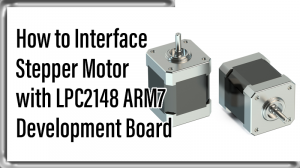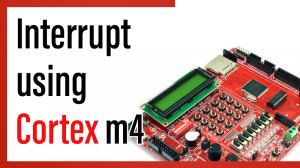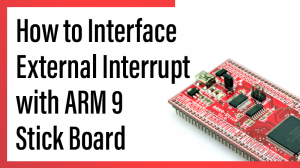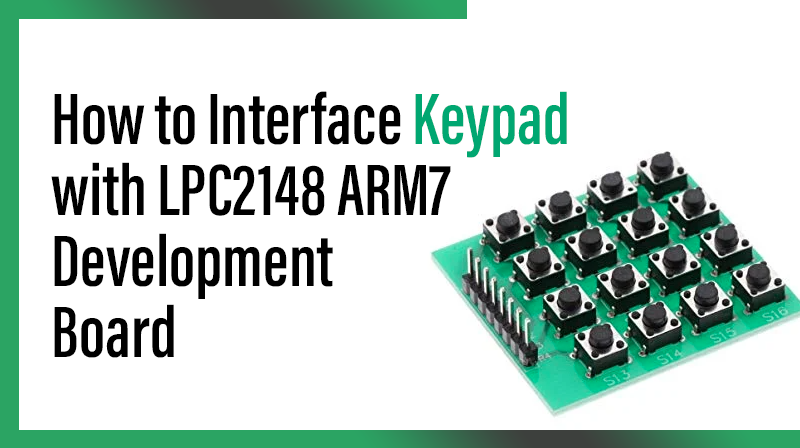
How to Interface Keypad with LPC2148 ARM7 Development Board
The ARM7 LPC2148 Development Board is specifically designed to help students to master the required skills in the area of embedded systems. The kit is designed in such way that all the possible features of the microcontroller will be easily used by the students. The kit supports in system programming (ISP) which is done through serial port.
NXP’s ARM7 (LPC2148), ARM Development Kit is proposed to smooth the progress of developing and debugging of various designs encompassing of High speed 32-bit Microcontrollers.
Keypad
A keypad is a set of buttons arranged in a block or “pad” which usually bear digits, symbols and usually a complete set of alphabetical letters. If it mostly contains numbers then it can also be called a numeric keypad. Here we are using 4 X 4 matrix keypad.
Interfacing keypad
Fig. 1 shows how to interface the 4 X 4 matrix keypad to two ports in microcontroller. The rows are connected to an output port and the columns are connected to an input port.
To detect a pressed key, the microcontroller grounds all rows by providing 0 to the output latch, and then it reads the columns. If the data read from the columns is D3-D0=1111, no key has been pressed and the process continues until a key press is detected. However, if one of the column bits has a zero, this means that a key press has occurred. For example, if D3-D0=1101, this means that a key in the D1 column has been pressed.
After a key press is detected, the microcontroller will go through the process of identifying the key. Starting with the top row, the microcontroller grounds it by providing a low to row D0 only; then it reads the columns.
If the data read is all 1s, no key in that row is activated and the process is moved to the next row. It grounds the next row, reads the columns, and checks for any zero. This process continues until the row is identified. After identification of the row in which the key has been pressed, the next task is to find out which column the pressed key belongs to.
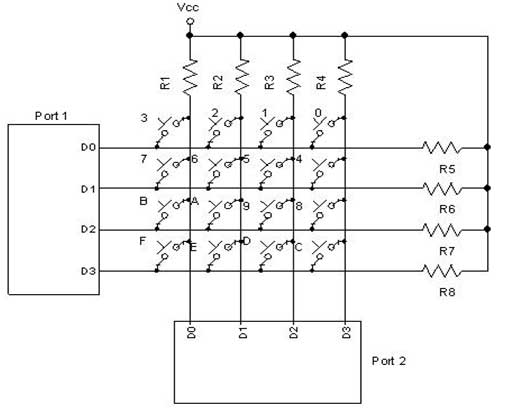
Interfacing keypad with LPC2148
Scan a keypad in LPC2148 Development Board. In case of 4X4 matrix Keypad both the ends of switches are connected to the port pin i.e. four rows and four columns. So in all sixteen switches have been interfaced using just eight lines.
1Keypads arranged by matrix format, each row and column section pulled by high or low by selection J5, all row lines(P1.24 – P1.27) and column lines(P1.28 to P1.31) connected directly by the port pins.
Pin Assignment with LPC2148
Circuit Diagram to Interface keypad with LPC2148
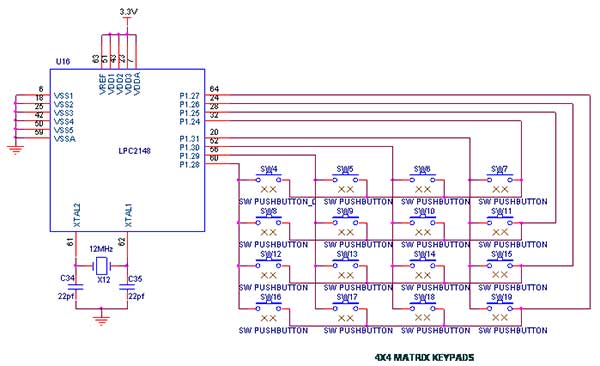
Source Code
The Interfacing keypad with LPC2148 program is very simple and straight forward, that scan a keypad rows and columns. When the rows and columns are detected then it will display in PC through UART0. The C programs are developed in Keil software.
C Program to Interface 4 X 4 matrix keypad using LPC2148
***************************************************************************************
Title : Program for keypad interfacing
***************************************************************************************
#include
#include
#include "Keypad.h"
#include "UART_Utility.c" extern void Delay(void);
unsigned char Row_Data, Col_Data;
unsigned char Msg[4][4] = { '0','1','2','3', '4','5','6','7', '8','9','A','B', 'C','D','E','F' };
void main(void)
{
VPBDIV = 0x02;
UART0_Init (9600);
PINSEL2 |= 0x0;
UART0_PutS ("\nPS-Development ARM LPC2148 Keypad Demo\n\r");
UART0_PutC (0xB8);
UART0_PutS (" Pantech Solutions Pvt Ltd., \n\r"); UART0_PutS (" www.pantechsolutions.net\n\r");
UART0_PutS ("----------------------------------------- \n\n\r");
UART0_PutS ("Keypad Ports : P1.24 - P1.31 \n\n\n\r");
UART0_PutS ("~~~~~~~~~~~~~~~~~~~~~~~~~~~~~~~~~~~~~~~~~~~\n\n\r");
while (1)
{
Delay();
Delay();
KeyScan(&IOPIN1,24,&Row_Data,&Col_Data);
UART0_PutS ("The Key You Pressed is : ");
if (Row_Data < 4 && Col_Data < 4)
{
U0THR = Msg[Row_Data][Col_Data];
Delay();
Delay();
U0THR = '\r';
}
}
}
void Delay(void)
{
unsigned int i,j;
for(i=0;i<35;i++)
for(j=0;j<1234;j++);
}To compile the above C code you need the KEIL software. They must be properly set up and a project with correct settings must be created in order to compile the code. To compile the above code, the C file must be added to the project.
In Keil, you want to develop or debug the project without any hardware setup. You must compile the code for generating HEX file. In debugging Mode, you want to check the port output without LPC2148 Development Board.
The Flash Magic software is used to download the hex file into your microcontroller IC LPC2148 through UART0.
Testing the Keypad with LPC2148
Give +3.3V power supply to LPC2148 Development Board; the serial cable is connected between the LPC2148 Development Board and PC. Open the Hyper Terminal screen, select which port you are using and set the default settings. Now the screen should show some text messages & it display which key is pressed in keypad.
If you not reading any text from UART0, then you just check the jumper connections & just check the serial cable is working. And also check the keypad keys are properly working or not. Otherwise you just check the code with debugging mode in Keil.
If you want to see more details about debugging just see the videos in below link.
☞ How to Create & Debug a Project in Keil.
General Information
☞For proper working use the components of exact values as shown in Circuit file. Wherever possible use new components.
☞Solder everything in a clean way. A major problem arises due to improper soldering, solder jumps and loose joints.
☞Use the exact value crystal shown in schematic.
☞More instructions are available in following articles,
How to Interface Switch with LPC2148 ARM7 Development Board

